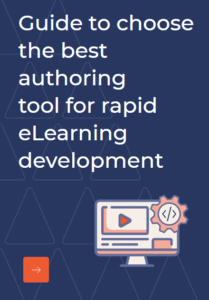In the words of Henry Mintzberg, OC OQ FRSC, a Canadian Academician and Author on business and management, ‘‘Management is above all, a practice where art, science and craft meets.’’ For successful completion of any project in an organization, project management is a necessity. Just like all other projects, eLearning project too requires proper management as it can quickly become unmanageable. The whole procedure of managing the eLearning project should be divided into organized steps as follows:eLearning courses
- Pre-inception
A well-defined project plan can save a lot of headaches that may crop up once the project launches. We should focus on the following components to create a project plan.
A. Know your project, goals, and objectives:
Setting goals in eLearning project can help in understanding what is to be achieved in that project. Objectives define how those goals can be achieved in the project.
B. Elucidate your team:
A good team is key to success in any organization. The main contributors in the success of an eLearning project are:
1. Project Manager who manages the schedule, cost, scope and quality of the project by working with the team and customers.
2. Instructional Designer(s) who analyzes and organizes contents, designs solutions, storyboards and scripts.
3. Subject Matter Expert(s) who helps in making the content more relevant and meaningful content in terms of the eLearning project.
4. Graphic Designer(s) who helps in creating user interface, graphics and animation for the eLearning project.
5. Course Authoring Specialist(s) who assembles all the elements into a functional course, adds interactivity and also ensures that course can be integrated with a learning management system.
6. Quality Assurance Team who help in ensuring the quality of the interactive eLearning applications, learning & content management system.
C. Securing acceptance & approval from stakeholders:
Identifying stakeholders and involving them throughout the project can help in ensuring that we don't miss out on any vital information. Getting approval from the stakeholders is an important process as it provides an opportunity to get more inputs from the stakeholders. This helps in improving the quality of the project. The delays in the project can be avoided by getting the stakeholders involved.
- Detailed Planning
Once the goal of the project and objectives of the project are determined, the team can make a detailed plan for the eLearning project. These are the points that must be essentially considered in the plan:
A. Task allocation, work breakdown:
It is always good to break down a complex set of tasks into manageable subtasks in the eLearning course. Then allocate the team members to the respective tasks based on their roles. It is also important to allocate each team member the reasonable amount of time to complete the task and achieving good quality eLearning as output.
B. Use Gantt chart:
Gantt chart is a visual view of scheduled tasks which can be used for planning any eLearning project. The chart lists out the tasks, the targeted date of completion, and the name of the team/member assigned to handle the task. It helps in estimating the time required to complete a particular eLearning course.
C. Risk management plan:
Risk in the project is always uncertain. But in case risk occurs it will cause loss to the project. Thus, having a risk management plan to avoid unnecessary losses in your project is a must. Different types of risks may occur at any stage of the project life cycle which includes technical risk, budget risk, market risk, client risk, political risk, environmental risk and so on. Past experiences of the project team and experts in industry can help to identify the risk that may occur.
Risk mitigation strategy can be used either to reduce the chances of occurrence of the possible risks or to reduce the impact of the identified risks. Below are the two types of mitigation strategies that can be used:
1. Preventative: This strategy is designed to reduce the likelihood of risk or seriousness of risk before the risk is even realized.
2. Contingency: This strategy determines which actions must be taken when risk is realized.
The process of project risk management must be done throughout the lifecycle of project. Because, as the project progresses there are chances that the project may encounter more risks.
- Project Execution
Project execution plays a pivotal role because that is when the actual execution of project begins. Generally, the project execution begins with kick-off meeting which helps to execute the project with minimal obstruction and proceeds with the following steps:
A. Project Status and Tracking:
Project status report is used to tally project progress against the project plan. Project status is usually reported by project manager and helps in monitoring and controlling various functions. Project status report generally includes:
1. General information about the project like name of the project, project manager, resources required etc.
2. Project summary status
3. Project milestone status
4. Project plan completion status
5. Project risk summary
This phase wise reporting helps each team member to stay engaged and on task and also allows the project manager to measure the progress of each task.
B. Quality Management:
Quality helps in differentiating the product and service in the high market competition. Quality assurance and quality control ensures that the course meets the necessary quality requirements and standards defined for the service. Quality assurance helps in assuring the client that quality requirements will be fulfilled. It helps in preventing defects and quality control helps in identifying defects. These two processes help in reducing the work of the reviewer, warrants quicker sign-off and allows to focus on enhancing the experience rather than fixing the mistakes. In eLearning courses it is required to focus on the aspects listed below :
1. Spelling, punctuation and grammar of text with the consistency of course, tone of voice and accuracy of figures.
2. Quality of graphics and images, alignment of text, brand guidelines and other elements.
3. Checking that the links launch as expected and that all interactive elements work properly.
4. Testing course on different browsers and operating systems and final acceptance testing.
The quality of deliverables is always a matter of concern. The project manager should apply the necessary checks and inspections to ensure the quality of deliverables.
C. Effort and cost tracking:
To run any project well, good estimation about effort and cost is required. It is the only way to know about how long the project will run and how much it cost. The effort tracking may contain the regular recording of the working hours according to project structure, consumables, payment to third parties, investment etc. Tracking cost involves estimating budgets, measuring results, updating forecast etc. The cost tracking first requires estimating the project budget by discussing with the team members. Following which the monthly cost of running the eLearning project should be determined and noted down.
- Project closure
This is the last phase of the eLearning project life cycle which formally closes the project.
Project closure report should consist of the following main points:
1. Project completion criteria
2. Plan to handover deliverables to customer
3. Plan to handover documents to customer
4. Close suppliers’ agreement
5. Release resources
The project closure report gives a confirmation that all the objectives of the project are met and that the deliverables have been handed over to customer. Hence, the project closure can be commenced. Once the project is closed, it is good to cross-check many aspects about the completed project by observing the post-project review, which may include the following:
1. Checking whether the project was within the scope
2. Checking project against estimated schedule
3. Comparing expenditure against budget
4. Checking whether all the objectives of the project were met.
Project post-implementation review helps in measuring the success of the project. Managing the eLearning project will no longer be a big deal if the steps discussed above are followed systematically.



